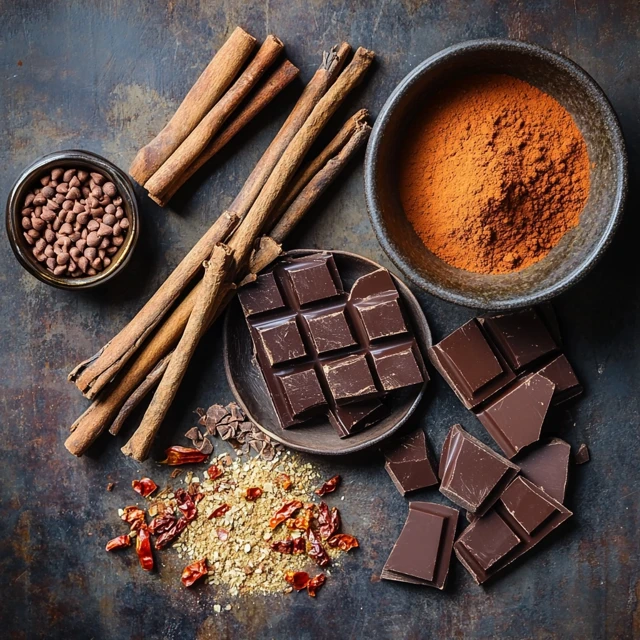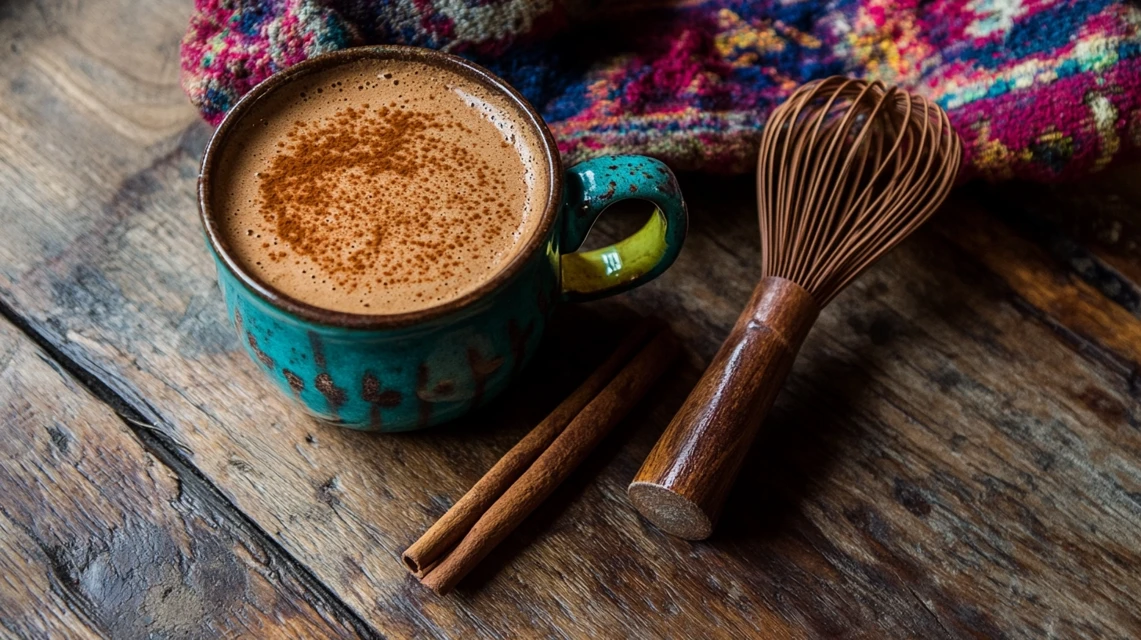Mexican hot chocolate is a rich, warm, and spiced drink that holds a special place in Mexican cuisine and culture. Unlike the regular hot chocolate many are familiar with, this version brings a unique blend of cocoa, spices, and tradition. It’s more than just a beverage—it’s an experience that combines flavor and history.
How It Differs from Regular Hot Chocolate
While both Mexican hot chocolate and regular hot chocolate share cocoa as their main ingredient, they differ significantly in flavor, preparation, and texture.
- Flavor Profile:
- Regular hot chocolate is usually sweet and smooth, often made with cocoa powder, sugar, and milk.
- Mexican hot chocolate incorporates spices like cinnamon, nutmeg, or chili powder, adding warmth and depth to its flavor.
- Texture:
- Traditional Mexican hot chocolate is slightly grainy due to the use of authentic Mexican chocolate tablets, which contain unrefined sugar and ground cocoa nibs.
- Preparation:
- Mexican hot chocolate is traditionally prepared using a wooden whisk called a molinillo, which helps create a frothy texture.
These differences make Mexican hot chocolate a unique and memorable drink.
Key Ingredients in Mexican Hot Chocolate

The ingredients in Mexican hot chocolate are simple but distinct, working together to create its signature taste.
- Mexican Chocolate Tablets: These are made from ground cocoa beans, sugar, and cinnamon. Some versions include almonds or vanilla.
- Milk or Water: Milk makes the drink creamy, while water offers a lighter version often preferred in traditional settings.
- Cinnamon: Ground cinnamon or a cinnamon stick adds a warm, spicy note.
- Chili Powder or Cayenne: A touch of heat gives the drink a subtle kick, balancing the sweetness.
- Sugar or Sweetener: Though Mexican chocolate is already sweetened, some recipes call for additional sugar to taste.
These ingredients blend to create a drink that is both comforting and exciting.
History and Cultural Significance
Mexican hot chocolate traces its roots back to the ancient civilizations of Mesoamerica, where the Aztecs and Mayans consumed a version of this drink. Known as xocoatl, this early form of hot chocolate was made by grinding cacao beans and mixing them with water, chili, and other spices. It was often consumed during rituals and seen as a gift from the gods.
Over time, the Spanish introduced sugar and milk to the drink, giving it a sweeter and creamier profile. Despite these changes, the cultural significance of Mexican hot chocolate remains strong. It is often enjoyed during special occasions, family gatherings, and celebrations like Día de los Muertos (Day of the Dead) or Christmas.
How to Make Authentic Mexican Hot Chocolate
Making Mexican hot chocolate at home is simple and rewarding. Whether you stick to the traditional recipe or try a modern twist, the result is a delicious drink that warms both body and soul.
Traditional Recipe and Methods
To make traditional Mexican hot chocolate, you’ll need the following ingredients:
- 2 cups of milk or water
- 1 Mexican chocolate tablet (like Ibarra or Abuelita)
- 1 cinnamon stick (optional)
Instructions:
- Heat the Liquid: In a saucepan, warm the milk or water over medium heat. Add the cinnamon stick if desired.
- Add the Chocolate: Break the chocolate tablet into pieces and stir it into the hot liquid.
- Whisk the Mixture: Use a molinillo or a whisk to vigorously stir the mixture until the chocolate dissolves and a frothy layer forms.
- Serve Hot: Pour into mugs and enjoy immediately.
The process of whisking not only blends the ingredients but also creates the traditional frothy texture that is a hallmark of this drink.
check out this https://eassyrecipes.com/category/breakfast/
Modern Twists on the Classic Drink
While the traditional recipe is timeless, there are many ways to adapt Mexican hot chocolate for modern tastes.
- Add Whipped Cream: Top the drink with whipped cream and a sprinkle of cinnamon for a decadent treat.
- Spice It Up: Enhance the flavor by adding a pinch of nutmeg, cayenne pepper, or even star anise.
- Experiment with Milk Alternatives: Try almond milk, oat milk, or coconut milk for a dairy-free version.
- Make It Boozy: Add a splash of rum, Kahlúa, or Bailey’s for an adult-friendly version.
These variations allow you to enjoy Mexican hot chocolate in new and exciting ways.
check out this https://eassyrecipes.com/category/breakfast/
Tips for Perfecting Your Recipe
Creating the perfect cup of Mexican hot chocolate requires attention to detail. Here are some tips to ensure your drink is as delicious as possible:
- Use Authentic Ingredients: Opt for Mexican chocolate tablets rather than generic cocoa powder for an authentic taste.
- Whisk Thoroughly: Don’t skip the frothing step; it enhances both texture and flavor.
- Adjust Sweetness: Taste as you go and add sugar sparingly if needed, as the chocolate tablets are often pre-sweetened.
- Serve Immediately: Mexican hot chocolate is best enjoyed fresh and piping hot, so don’t let it sit too long after preparation.
By following these tips, you’ll create a rich, flavorful drink that captures the essence of Mexican hot chocolate.
Why Mexican Hot Chocolate Stands Out

Mexican hot chocolate is more than just a warm beverage. Its rich flavors and deep cultural roots make it unique and cherished worldwide. The drink’s distinct combination of ingredients, its role in celebrations, and the surprising health benefits of its spices all contribute to its enduring popularity.
Unique Spices and Flavors
One of the defining characteristics of Mexican hot chocolate is its bold and distinctive flavor profile. Unlike traditional hot chocolate, which is typically sweet and creamy, Mexican hot chocolate incorporates a variety of spices that add warmth, complexity, and depth.
Key Flavors:
- Cinnamon: This warm spice is a staple in Mexican hot chocolate. It complements the richness of cocoa while adding a sweet, aromatic touch.
- Chili Powder or Cayenne Pepper: A subtle hint of chili gives the drink a gentle kick, balancing the sweetness and making it more exciting to the palate.
- Vanilla: Often added to enhance the overall flavor, vanilla gives Mexican chocolate a smooth and inviting quality.
- Nutmeg or Star Anise: Some variations include additional spices like nutmeg or star anise for a more complex taste.
These spices not only elevate the drink’s flavor but also set it apart from other types of hot chocolate. Each sip is an experience, blending sweet, spicy, and earthy notes into a harmonious whole.
The Role of Mexican Hot Chocolate in Celebrations
Mexican hot chocolate is more than just a drink; it’s a cultural symbol deeply tied to celebrations and traditions. It plays an important role in bringing families and communities together during special occasions.
Cultural Significance:
- Día de los Muertos (Day of the Dead): During this important Mexican holiday, families often prepare Mexican chocolate as part of offerings to their departed loved ones. It is enjoyed alongside pan de muerto, a traditional sweet bread.
- Christmas and Winter Gatherings: Mexican hot chocolate is a festive favorite during the holiday season. Its warmth and comforting flavors make it perfect for cold-weather celebrations.
- Family Traditions: Many families have their own recipes for Mexican chocolate, passed down through generations. Preparing the drink together is often a cherished ritual.
By sharing Mexican chocolate at these events, people honor their heritage, create lasting memories, and strengthen bonds with loved ones.
check out this https://eassyrecipes.com/category/breakfast/
Health Benefits of Spices Used
Beyond its delicious flavor, Mexican chocolate offers surprising health benefits, thanks to the spices used in its preparation. These spices not only enhance the taste but also contribute to overall well-being.
Cinnamon:
- Blood Sugar Regulation: Cinnamon is known for its ability to help stabilize blood sugar levels, making it beneficial for those managing diabetes or seeking balanced energy.
- Anti-Inflammatory Properties: It has anti-inflammatory effects, which can support joint health and reduce chronic inflammation.
- Rich in Antioxidants: Cinnamon is loaded with antioxidants that protect the body from oxidative stress.
Chili Powder or Cayenne Pepper:
- Boosts Metabolism: The capsaicin in chili peppers can help boost metabolism and promote fat burning.
- Heart Health: Chili powder may improve circulation and support heart health by reducing blood pressure.
- Immune Support: The spice contains vitamins A and C, which support a strong immune system.
Cocoa:
- Mood Enhancement: Cocoa contains compounds like theobromine and serotonin precursors, which can help improve mood and reduce stress.
- Heart Health: Rich in flavonoids, cocoa can support cardiovascular health by improving blood flow and reducing the risk of heart disease.
- Cognitive Benefits: The antioxidants in cocoa may enhance brain function and protect against age-related cognitive decline.
Vanilla:
- Calming Effect: Vanilla has soothing properties that can help reduce stress and promote relaxation.
- Rich Flavor Without Calories: It adds a sweet, aromatic taste without the need for additional sugar.
By blending these spices into a single drink, Mexican chocolate delivers not only indulgent flavors but also healthful benefits, making it a satisfying and functional treat.
FAQs About Mexican Hot Chocolate
Mexican chocolate has captured the hearts of many with its rich flavors, cultural significance, and unique preparation. Below are answers to common questions that highlight what sets it apart from other hot chocolate varieties.
What Makes Mexican Hot Chocolate Different?
Mexican hot chocolate stands out for its distinctive ingredients and preparation methods. Unlike regular hot chocolate, it features a blend of cocoa, spices, and traditional techniques that create a bold and unique flavor profile.
Key Differences:
- Spices: The addition of cinnamon and chili powder or cayenne gives Mexican chocolate its warm and slightly spicy kick. These spices balance the sweetness of the drink, creating a more complex flavor.
- Texture: Traditional Mexican chocolate is often grainier than regular hot chocolate due to the use of authentic Mexican chocolate tablets, which contain ground cocoa nibs and unrefined sugar.
- Preparation: A wooden whisk called a molinillo is used to froth the drink, creating a foamy top layer that enhances the experience.
These elements combine to make Mexican chocolate an unforgettable treat that is both comforting and exciting.
What Is the Difference Between Hot Chocolate and Champurrado?
Though Mexicans cherish both hot chocolate and champurrado as warm beverages, their ingredients and textures differ significantly.
Hot Chocolate:
- Made with Mexican chocolate tablets dissolved in milk or water.
- Sweet and spiced, often including cinnamon and chili for added depth.
- Has a thinner consistency compared to champurrado.
Champurrado:
- A thicker drink made by combining masa harina (corn flour) with chocolate, milk or water, and spices like cinnamon and anise.
- Its thickness comes from the masa harina, which gives it a hearty, almost porridge-like consistency.
- Often served during holidays or as an accompaniment to tamales.
In Summary:
Hot chocolate is a lighter, spiced drink, while champurrado is thicker and heartier due to the addition of masa harina. Both are deeply rooted in Mexican culinary traditions.
What Is the Mexican Name for Hot Chocolate?
In Mexico, hot chocolate is commonly referred to as chocolate caliente. The term directly translates to “hot chocolate” and encompasses the traditional preparation using Mexican chocolate tablets and spices.
Types of Mexican Chocolate Used:
- Ibarra: A popular brand of Mexican chocolate known for its rich flavor and ease of preparation.
- Abuelita: Another well-loved brand, offering a slightly sweeter option with hints of cinnamon.
- Artisanal Chocolate: Many regions in Mexico produce handmade chocolate tablets, which add a local flair to the drink.
While chocolate caliente is the general term, regional variations and family recipes often make each cup unique.
Why Is Mexican Hot Chocolate Gritty?
The grainy texture of Mexican chocolate defines its character, stemming from the traditional way makers grind and process the chocolate.Unlike the smooth, processed cocoa used in regular hot chocolate, Mexican chocolate retains its natural texture.
Reasons for the Grittiness:
- Unrefined Sugar: The chocolate tablets contain granulated, unrefined sugar, which doesn’t fully dissolve during preparation.
- Ground Cocoa Nibs: The use of minimally processed cocoa nibs adds a slight graininess that enhances the rustic feel of the drink.
- Traditional Methods: The molinillo froths the hot chocolate but doesn’t completely smooth out the ingredients, preserving the authentic texture.
Many people find the gritty texture to be part of the charm of Mexican chocolate, adding to its authenticity and uniqueness.
Conclusion
Mexican hot chocolate is more than just a drink—it’s a cultural treasure that combines history, flavor, and tradition. Its bold spices, distinctive preparation, and rich heritage set it apart from other hot chocolate varieties. Whether you’re savoring its unique texture, exploring its connection to celebrations, or trying a homemade recipe, Mexican chocolate offers an experience that warms the soul and excites the palate. By understanding its differences, traditions, and flavors, you can truly appreciate why this beloved drink continues to captivate people around the world.

